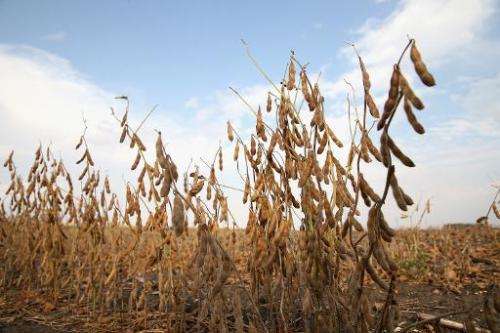Winners and losers in cereal production from El Nino

Food experts on Thursday drew up the first global map of how the El Nino weather phenomenon affects production of four key cereals.
El Nino improves the global yield of soybeans by 2.1 to 5.4 percent, but changes the yields of maize, rice and wheat by -4.3 percent to +0.8 percent, they said.
When El Nino goes into reverse, a process called La Nina, the change in global average yields of all four crops range from zero to -4.5 percent, according to a study in the journal Nature Communications.
El Nino is the name for a pendulum swing in weather patterns that can cause widespread disruption.
It occurs when a huge mass of warm water builds in the western Pacific and eventually shifts to the eastern side of the ocean.
The warmth typically brings exceptional rainfall to usually arid countries in western South America and causes drought and dryness in the tropical western Pacific, with knock-on effects in other continents.
The return of the pendulum, La Nina, is a cold phase that usually occurs the following year.
The study, led by Toshichika Iizumi of the National Institute for Agro-Environmental Sciences in Tsukuba, Japan, is based on harvest data from 1984 to 2004 in producer countries.
El Nino, they found, has a negative impact on maize, also called corn, in the southeastern United States, China, East and West Africa, Mexico and Indonesia.
It also reduces yields of soybean in India and parts of China.
Slimmer harvests of rice occur in southern China, Myanmar and Tanzania, and of wheat in part of China, the United States, Australia, Mexico and parts of Europe.
Conversely, El Ninos have a positive effect on about a third of land where these four crops are grown.
Beneficiaries include Brazil and Argentina for maize; the United States and Brazil for soybean; rice in parts of China and Indonesia, and wheat in Argentina and part of South Africa.

On April 14, the UN's World Meteorological Organization (WMO) said there was a "fairly large potential" for an El Nino to develop by the end of 2014.
El Nino events occur roughly every three to seven years but became more frequent and intense in the late 20th century, with the 1982-3 and 1997-8 episodes the strongest of all.
The last El Nino occurred between June 2009 and May 2010.
More information: Paper: Impacts of El Niño Southern Oscillation on the global yields of major crops. Toshichika Iizumi, et al. Nature Communications 5, Article number: 3712 doi:10.1038/ncomms4712. Received 10 October 2013 Accepted 24 March 2014 Published 15 May 2014 dx.doi.org/10.1038/ncomms4712
Journal information: Nature Communications
© 2014 AFP




















